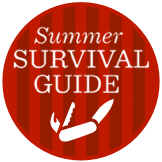Growing up, the summer was always a time of unabashed freedom. No school, longer days and a group of friends were all you needed to get into just the right amount of trouble. Of course, our parents always warned us of the potential risks, but as adults we know better. Or do we? Myths, especially health myths, tend to stick with us because they make sense to us, on some level, says Dr. Rachel Vreeman, who wrote about the phenomenon in her book "Don't Cross Your Eyes ... They'll Get Stuck That Way." Don't swim for 30 minutes after eating? Not necessary, but you've thought about it before haven't you? Herewith, six summer myths, busted for your enjoyment.
Myth:
Waterlogged ears? Stand on one foot and hop.
False. While this could change the pressure within the ear canal, it's a silly way to accomplish your task. A quicker way that's both discreet and effective is to create a vacuum in your ear by tilting the waterlogged ear towards the floor, covering your ear with your palm and pushing in and out until the water's released. Or position your thumb behind the ear on the cartilage above your earlobe and wiggle to straighten the ear canal.
Myth:
Going in and out of air-conditioning will make you sick.
False. Temperature swings, no matter how drastic, won't cause a cold—unless the bacteria or virus is already present in the body, says Ron Eccles, director of the Common Cold Centre at Cardiff University in Wales. The building's air won't harm you, but the germs inside just might. Viruses and bacteria can survive on things like doorknobs and buttons for hours. So as long as you wash your hands regularly, you're good to go.
Myth:
You've got pee on a jellyfish sting.
False. Urinating on a jellyfish sting will make it worse, says Jennifer Ping, an ER physician at Straub Clinic and Hospital in Honolulu, who's studied the best sting treatments. Instead, remove the tentacles (without touching them with your hands), then deactivate the stinging cells known as nematocytes with vinegar and scrape them off with a credit card. Urine has a different pH than vinegar and, like water, will actually cause the nematocytes to swell and release more venom.
Myth:
Beware of people with poison ivy. You can catch it.
False. Even the ugliest poison ivy rash is not contagious. It's the plant's oils that are contagious—not the body's reaction to it. Poison ivy causes a delayed response, so a rash doesn't appear for up to 72 hours after contact with the oils found on the plant's leaves. According to the American Academy of Dermatology, the blisters can't spread the rash to other people (nor to other parts of the infected person's body). The oils can however stick around on clothes and shoes, so be sure to wash everything that may've brushed against the ivy.
Myth:
The water from a hose isn't fit to drink.
Half true. Your mom probably warned you not to drink from the hose and while the water can taste a little gnarly, there aren't any germs that live specifically in garden hoses. However, the end of the hose or nozzle has been touched by a handful of people and may've been dropped in the dirt or even dragged through a pet's poop. So you're better off not drinking from it (and if you do, just keep your lips off it).
Myth:
Scratching a bug bite makes it worse.
True. When you scratch, you ignite immune-system messenger proteins at the site, which intensifies the itch. And, according to Vreeman, scratching definitely makes bites look worse as the irritation can cause more redness and swelling or lead to an infection. An old camp trick that does work? Hold an ice cube (or chilled can) on the bite, which slows the body's chemical signals at the site.
